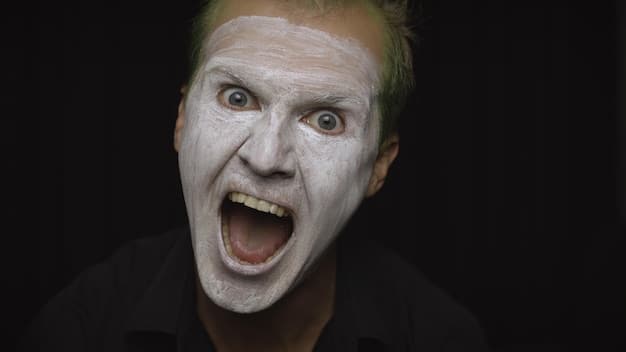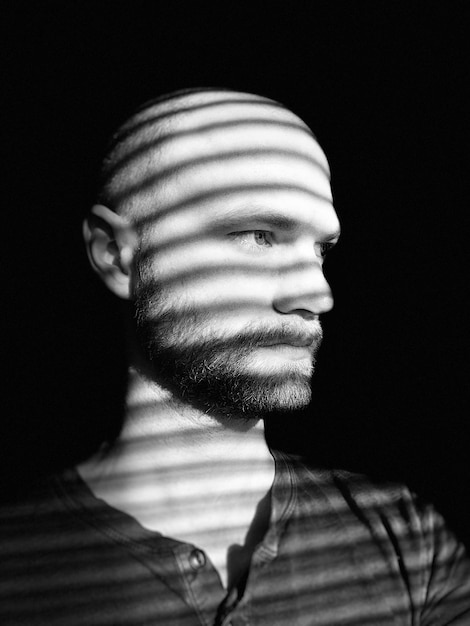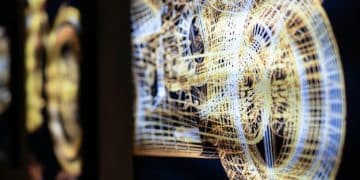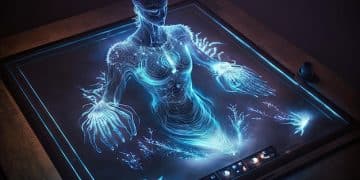The Psychology of Horror: Why We Love Being Scared

The enduring allure of horror stems from a complex interplay of psychological factors, including catharsis, the thrill of controlled fear, and the unique opportunity to confront existential anxieties in a safe, simulated environment.
Delving into the macabre might seem counterintuitive for pleasure, yet millions worldwide actively seek out fright. This article explores The Psychology of Horror: Why We Love to Be Scared, uncovering the intricate neurological and emotional mechanisms that draw us to the dark side of entertainment.
The Paradox of Fear: A Deep Dive into Our Attraction to Horror
The human relationship with fear is often paradoxical. While our instincts drive us to avoid threats, horror entertainment invites us to confront them willingly. This section explores the fundamental reasons behind our peculiar fascination with being scared, examining the biological and psychological underpinnings.
Understanding this paradox requires an exploration of our evolutionary history. Fear, as an ancient survival mechanism, primes our bodies for “fight or flight.” When encountering a perceived threat in a controlled environment, such as a horror film, this primal response is triggered without actual danger, offering a unique thrill.
The Adrenaline Rush and Dopamine Release
One of the most immediate physiological responses to fear is the release of adrenaline. This hormone prepares our body for action, leading to increased heart rate, heightened senses, and a surge of energy. Following a fright, the brain often rewards this experience with a release of dopamine, creating a pleasurable sensation that can be addictive.
- Physiological Arousal: Horror content stimulates the sympathetic nervous system, leading to a natural “high.”
- Chemical Reward: The post-fear relief often results in dopamine, serotonin, and oxytocin release, fostering positive feelings.
- Controlled Environment: The safety of knowing the threat isn’t real allows us to enjoy the physiological effects without genuine danger.
This biochemical cocktail contributes significantly to the appeal of horror. It’s a natural form of self-medication, a way to experience intense emotions and then dissipate them safely. For many, it’s a form of emotional regulation, allowing them to process strong feelings in a low-stakes setting.
Coping Mechanisms and Catharsis
Horror provides a valuable outlet for confronting anxieties and processing emotions. The genre often explores themes of vulnerability, death, and social collapse, allowing viewers to engage with these existential fears from a safe distance. This can be deeply cathartic, offering a release of pent-up emotional tension.
- Emotional Processing: Viewers can explore feelings of dread, anxiety, and helplessness in a controlled setting.
- Stress Release: The screaming and physical reactions often associated with horror viewing can relieve stress.
- Vicarious Experience: We safely confront our deepest fears through the characters, learning about human resilience.
By engaging with terrifying scenarios, we can better understand our own reactions to stress and adversity. It serves as a form of emotional rehearsal, preparing us, on a subconscious level, for potential real-world challenges. This makes the attraction to horror not just about the thrill, but also about self-discovery and emotional growth.
Ultimately, our attraction to horror is not simply about being scared; it’s about the complex interplay of physiological responses, the release of feel-good chemicals, and the profound psychological benefits of confronting our fears in a secure environment. It’s a dynamic and multifaceted experience that caters to deep-seated human needs and curiosities.
The Power of Narrative: How Storytelling Amplifies Fear
Beyond immediate jump scares, the enduring impact of horror often lies in its narrative depth. Storytelling allows for the slow build of dread, the development of complex characters, and the exploration of themes that resonate deeply with human experience. This section delves into how narrative techniques enhance the psychological impact of horror.
A well-crafted horror narrative doesn’t just present frightening images; it constructs an atmosphere of unease and suspense. This process often involves manipulating pacing, utilizing foreshadowing, and developing characters with whom we can empathize, making their struggles and eventual terrors far more impactful.
Suspense and Anticipation: The Slow Burn
True horror often relies less on sudden shocks and more on the psychological torment of anticipation. The “slow burn” approach builds tension gradually, allowing the audience to imagine the horrors to come, which can often be more terrifying than the revealed monster itself. This technique taps into our natural unease with the unknown.
- Pacing: Deliberate slowness builds dread, making payoffs more effective.
- Foreshadowing: Hints and clues create a sense of impending doom, increasing anxiety.
- Ambiguity: What is unseen or merely suggested often triggers the imagination more powerfully.
The power of suggestion is paramount. When our minds are left to fill in the blanks, our personal fears often become the most potent components of the narrative. This collaborative effort between storyteller and audience ensures a deeper, more personalized sense of terror that lingers long after the credits roll.
Archetypes and Universal Fears: Connecting with Primal Anxieties
Horror narratives frequently draw upon universal human fears and archetypes that resonate across cultures and generations. These include fear of the unknown, fear of death, loss of control, and the monstrous other. By tapping into these primal anxieties, horror can achieve a profound psychological effect.
From ancient myths to modern films, stories of malevolent forces, lurking shadows, and existential threats have populated human imagination. These narratives often reflect societal anxieties and cultural fears, providing a safe space to explore and process them.
- Existential Dread: Narratives often explore themes of mortality, meaninglessness, and the fragility of existence.
- Loss of Control: Stories where characters lose agency tap into deep-seated fears about helplessness.
- The Monstrous Other: Villains often personify societal fears or repressed individual desires, making them potent symbols.
The effectiveness of horror narratives lies in their ability to make the intangible tangible, to give a face to our greatest fears. By embodying these universal concerns in compelling stories, horror offers a unique mirror to our collective psyche, allowing us to confront what we often try to avoid in daily life. This narrative power elevates horror from mere entertainment to a profound form of cultural introspection.
The Social Aspect: Shared Fear and Bonding Experiences
While often viewed as an individual experience, watching horror can be a deeply social activity. The shared experience of fear, the collective screams, and the subsequent relief can foster strong bonds and create memorable group experiences. This section explores the social psychology behind enjoying horror in groups.
From crowded movie theaters to living room gatherings, engaging with horror alongside others amplifies its effects. There’s a certain validation in knowing that others are experiencing similar physiological and emotional responses, building a unique sense of camaraderie.
Collective Thrill and Arousal Transfer
When people experience intense emotions together, those emotions can sometimes transfer between individuals, a phenomenon known as arousal transfer. In a group setting, one person’s scream or jump can trigger similar reactions in others, intensifying the overall experience for everyone. This communal aspect adds another layer to the thrill.
The shared tension and release create a powerful collective effervescence. Laughter and screams become synchronized, creating a shared rhythm of fear and relief. This can strengthen social connections and create lasting memories that are often revisited and recounted.
- Enhanced Reaction: Group reactions can amplify individual fear and excitement.
- Validation: Seeing others react confirms the legitimacy of one’s own fear, reducing isolation.
- Shared Memory: Collective experiences of terror often create strong, memorable bonds.
This dynamic ensures that horror is not just a personal journey into fright, but a communal ritual. It transforms a solitary encounter with fear into a shared adventure, which can be far more rewarding and memorable than experiencing it alone.
Group Cohesion and Post-Fear Debriefing
Surviving a horror film together, even vicariously, can act as a bonding experience. The aftermath often involves lively discussions, recounting the scariest moments, and analyzing the plot. This “debriefing” period allows participants to process the experience, share their reactions, and reinforce social ties.

The post-movie chat is crucial. It’s a chance to release lingering tension, laugh at the absurdity, or discuss the deeper themes. This communal processing helps normalize the intense emotions felt during the film, turning potential discomfort into a shared narrative of triumph over terror.
- Narrative Sharing: Discussing the film reinforces the bond formed during the viewing.
- Emotional Processing: Talking about fears helps integrate the experience positively.
- Sense of Safety: The group provides a reassuring presence, reconfirming that the danger was fictitious.
Participating in horror as a group transforms a potentially isolating experience into a powerful social ritual. It allows individuals to navigate intense psychological landscapes together, strengthening interpersonal connections and creating a unique shared understanding. It’s a testament to how even fear can bring people closer.
The Role of Control and Safety in Enjoying Fear
Perhaps paradoxically, our enjoyment of horror hinges significantly on our sense of safety and control. The ability to engage with terrifying scenarios from a position of absolute security is crucial to the appeal. This section explores how this psychological distance enables us to derive pleasure from fear.
Without the implicit understanding that the danger is not real, the experience would shift from entertainment to genuine trauma. It’s the cognitive awareness of insulation from harm that allows for physiological arousal without genuine distress, enabling enjoyment.
The “Fight-or-Flight” Mechanism in a Safe Context
Our autonomous nervous system doesn’t fully distinguish between real and simulated threats. When exposed to horror, the body engages its primal “fight-or-flight” response, releasing adrenaline and cortisol. However, because the threat is contained within a screen or controlled environment, we experience the rush without the danger.
- Simulated Threat: The body reacts as if in danger, but the mind knows it’s safe.
- Adrenaline Without Consequence: We get the exhilarating chemical rush without actual physical harm.
- Prefrontal Cortex Activity: The rational part of the brain actively reminds us that it’s “just a movie.”
This delicate balance between physiological activation and cognitive awareness creates a unique form of embodied experience. We are fully immersed yet paradoxically detached enough to process the fear as a form of entertainment rather than an actual threat, leading to a sense of mastery over intense emotions.
The “Optimal Arousal” Theory and Challenge
Psychologist Frank Farley proposed the concept of “Type T” (Thrill-Seeking) personalities, suggesting some individuals have a higher need for physiological arousal. More broadly, the optimal arousal theory posits that individuals seek an ideal level of stimulation. Horror, by providing intense but controlled stimulation, helps some achieve this optimal state.
It’s akin to riding a rollercoaster: the thrill comes from the perceived danger and the mastery over it. Horror provides a similar psychological roller-coaster, presenting challenges that test our emotional limits but ultimately allow us to emerge victorious and feeling more capable.
- Sensory Input: Loud noises, intense visuals, and suspense trigger our senses.
- Emotional Challenge: Viewers test their ability to withstand discomfort and fear.
- Sense of Mastery: Successfully enduring a scary experience can boost self-confidence.
The delicate interplay of control and safety is what transforms potential trauma into thrilling entertainment. It allows us to dance on the edge of terror, exploring the very limits of our comfort zones, all while remaining firmly grounded in the reassuring embrace of reality and safety. This sophisticated psychological balancing act is fundamental to the enduring appeal of horror.
Exploring the Dark Side: Identity and the Shadow Self
Horror often delves into the darker aspects of human nature and society, allowing individuals to explore forbidden thoughts, taboos, and the “shadow self” within a fictional context. This engagement with the unsettling can be a profound psychological journey, offering insights into personal identity and collective anxieties.
The genre often functions as a mirror, reflecting anxieties about morality, power, and the primal urges that society often represses. By engaging with these dark themes, we can safely acknowledge and even process our own complex inner landscapes.
Confronting Taboos and the Unconscious
Horror frequently tackles subjects that are considered taboo in polite society, such as death, gore, madness, and extreme violence. By portraying these elements, it allows viewers to grapple with concepts that are typically suppressed, offering a form of psychological release or exploration.
This deliberate breaking of societal norms can be both shocking and liberating. It pushes boundaries, forcing us to examine what frightens us on a deeper, more primal level, often linking to subconscious fears and anxieties about our own destructive capacities or vulnerability.
- Societal Anxieties: Horror often reflects and explores contemporary cultural fears and taboos.
- Moral Exploration: Characters frequently face ethical dilemmas that challenge viewer’s own values.
- Repressed Desires: The genre can provide an outlet for vicarious exploration of dark urges.
Through its unflinching gaze into the grotesque and the forbidden, horror enables a unique psychological processing. It offers a safe space to acknowledge and confront the aspects of humanity that are often deemed too uncomfortable or dangerous for everyday discourse, facilitating a form of cognitive and emotional catharsis.
Identity Formation and Self-Discovery
For some, particularly adolescents and young adults, horror can play a role in identity formation. Engaging with the genre allows individuals to test their own boundaries, assess their reactions to extreme situations, and understand more about their own resilience and preferences for thrill-seeking.

Horror films can also serve as a rite of passage, a shared experience that marks a transition into a certain social group or maturity level. Surviving a truly terrifying film can be a personal triumph, affirming strength and courage in the face of simulated adversity.
- Boundary Testing: Individuals explore their personal limits regarding gore, fear, and discomfort.
- Resilience Building: Successfully coping with a scary narrative can enhance feelings of emotional strength.
- Self-Awareness: Reactions to horror can reveal personal fears, triggers, and coping styles.
Ultimately, by plumbing the depths of human darkness and despair, horror provides a unique avenue for self-discovery. It forces us to confront uncomfortable truths, both about the world and ourselves, often leaving us with a deeper understanding of our own psychological makeup and our place in a complex, often terrifying, universe.
The Evolution of Horror: From Folklores to Modern Psychological Thrillers
The genre of horror has undergone a significant evolution, reflecting changing societal anxieties, technological advancements, and a deepening understanding of the human psyche. From ancient oral traditions to contemporary cinematic masterpieces, horror’s diverse forms offer insights into what truly frightens us across different eras.
Tracing this evolution reveals how our fears shift from external, tangible threats to more internal, psychological ones. Each era redefines what it means to be scared, adapting the genre to resonate with the specific concerns of its time.
Ancient Roots and Gothic Literature
Horror’s origins can be traced back to ancient folklores, myths, and cautionary tales that often featured supernatural beings, vengeful spirits, and moralistic lessons. These early narratives aimed to instill fear to enforce social norms or explain the inexplicable.
The 18th and 19th centuries saw the rise of Gothic literature, which introduced elements like haunted castles, brooding aristocrats, and psychological torment. Authors like Mary Shelley, Edgar Allan Poe, and Bram Stoker laid the groundwork for modern horror, blending supernatural dread with deep dives into human psychology.
- Folk Tales: Early stories often personified natural dangers and moral failings through mythical creatures.
- Gothic Tropes: Focus on atmosphere, psychological decay, and the sublime terror of the supernatural.
- Literary Influence: Established narrative conventions and character archetypes for the genre.
These foundational works cemented horror as a legitimate literary and thematic exploration, moving beyond simple frights to probe the complex undercurrents of human experience and the limits of scientific understanding.
Cinematic Innovations and Subgenre Diversification
The advent of cinema revolutionized horror, giving it a powerful new medium for expression. Early films utilized visual effects and suspense to shock audiences, while later decades saw the emergence of various subgenres, each addressing distinct fears.
From the monstrous creatures of the 1930s to the psychological thrillers of the 1960s, the slasher films of the 1980s, and the found-footage phenomena of the 2000s, horror cinema continually adapts. Each subgenre reflects the anxieties prevalent at its time of popularity, from nuclear fears to societal violence.
- Technological Impact: Sound, special effects, and editing drastically enhance the horror experience.
- Subgenre Proliferation: Creation of distinct categories like slasher, psychological, found-footage, and body horror.
- Cultural Reflection: Movies often mirror contemporary socio-political issues and collective anxieties.
Modern horror continues to innovate, often blending subgenres and employing sophisticated narrative structures to explore complex psychological themes. It’s a dynamic genre that remains intensely relevant by consistently evolving to reflect and challenge the changing landscape of human fears.
The Future of Fear: Immersive Experiences and Psychological Depth
As technology advances and our understanding of psychology deepens, the future of horror promises even more immersive and psychologically nuanced experiences. From virtual reality to interactive narratives, the ways we engage with fear are set to evolve, pushing the boundaries of what is possible within the genre.
The trajectory suggests a move towards highly personalized and deeply internal encounters with fear, leveraging new technologies to bypass traditional viewing barriers and amplify the psychological impact on the individual.
Virtual Reality and Immersive Environments
Virtual reality (VR) offers an unprecedented level of immersion, potentially making horror experiences far more potent. By placing viewers directly within the terrifying scenario, VR bypasses the screen’s psychological distance, fostering a more visceral and immediate sense of dread.
The ability to look around freely within a terrifying environment, combined with haptic feedback and spatial audio, could blur the lines between reality and simulation, unlocking new dimensions of fear previously inaccessible through traditional media. This introduces unique ethical considerations about the psychological impact on users.
- Sensory Overload: VR’s ability to engage multiple senses creates a richer, more terrifying experience.
- Loss of Control: The heightened immersion can diminish the sense of safety, intensifying fear.
- Personalized Terror: Future VR experiences may adapt to individual fears for maximum impact.
The potential of VR to deliver truly immersive horror is immense, promising an era where the boundary between observer and participant becomes increasingly, and terrifyingly, indistinct. This could fundamentally alter how we perceive and engage with the genre as entertainment.
Interactive Narratives and Personalized Fear
Beyond VR, the future of horror may involve more interactive narratives, allowing viewers to influence the story’s progression and outcomes. This shift from passive consumption to active participation could enhance the sense of agency – or horrifying lack thereof – within the narrative.
Imagine choosing your character’s actions or confronting dilemmas that specifically target your known anxieties. This level of personalization, potentially driven by AI that learns user preferences, could make horror an intensely individualized and unsettling experience, tailored to evoke your deepest, most specific fears.
- Increased Agency: Viewers become active participants, intensifying emotional investment.
- Adaptive Storytelling: AI could tailor narratives to individual psychological profiles.
- Ethical Considerations: Greater personalization raises questions about psychological impact and boundaries.
These advancements suggest a future where horror is not just watched but actively lived, offering an unparalleled level of psychological penetration. The genre will continue to evolve, always pushing to find new ways to tap into our primal fears and our enduring fascination with the dark side of the human experience.
| Key Point | Brief Description |
|---|---|
| ⚡ Adrenaline Rush | Controlled fear triggers physiological arousal followed by satisfying dopamine release. |
| 🧠 Psychological Catharsis | Horror allows safe confrontation of anxieties and emotional processing. |
| 🤝 Social Bonding | Shared fear experiences strengthen emotional connections and camaraderie. |
| 🌐 Controlled Safety | Appreciation of horror relies on knowing threats are fictional, ensuring emotional safety. |
Frequently Asked Questions
▼
Individual preferences for horror vary due to differences in personality traits, past experiences, and physiological arousal thresholds. For some, the controlled rush of adrenaline is pleasurable, while others find the discomfort overwhelming or seek different forms of stimulation.
▼
For some, watching horror can offer catharsis, stress relief, and a safe way to confront anxieties. It allows emotional processing in a controlled environment. However, for individuals prone to anxiety or trauma, it can be detrimental, causing increased stress or triggering existing issues.
▼
The “safe danger” theory suggests that people enjoy horror because it allows them to experience the physiological symptoms of fear (e.g., increased heart rate, adrenaline) without any actual risk. The brain registers the threat as non-real, converting potential distress into excitement.
▼
Some research indicates that engaging with fictional threats in horror can help individuals develop coping mechanisms for real-life stress and anxiety. It can act as a form of exposure therapy, building resilience by safely simulating dangerous situations and observing characters navigate them.
▼
Suspense is crucial in horror because it builds anticipation and tension, often more effectively than immediate jump scares. It engages the audience’s imagination, allowing their own fears to fill in the unknown, leading to a deeper, more lasting sense of dread and excitement.
Conclusion
The enduring human fascination with horror is demonstrably more complex than a simple desire to be scared. It is a nuanced psychological phenomenon, intertwining biological responses with cognitive processes and social dynamics. From the primal thrill of an adrenaline rush in a safe environment to the profound catharsis of confronting existential anxieties through narrative, horror serves myriad psychological purposes. Whether as a unique form of stress relief, a tool for identity exploration, or a powerful social bonding ritual, the genre continues to evolve, reflecting and shaping our collective understanding of fear. As technology progresses, the future promises even more immersive and personalized experiences, ensuring that our ancient, paradoxical love affair with being scared will continue to captivate and challenge us for generations to come.





